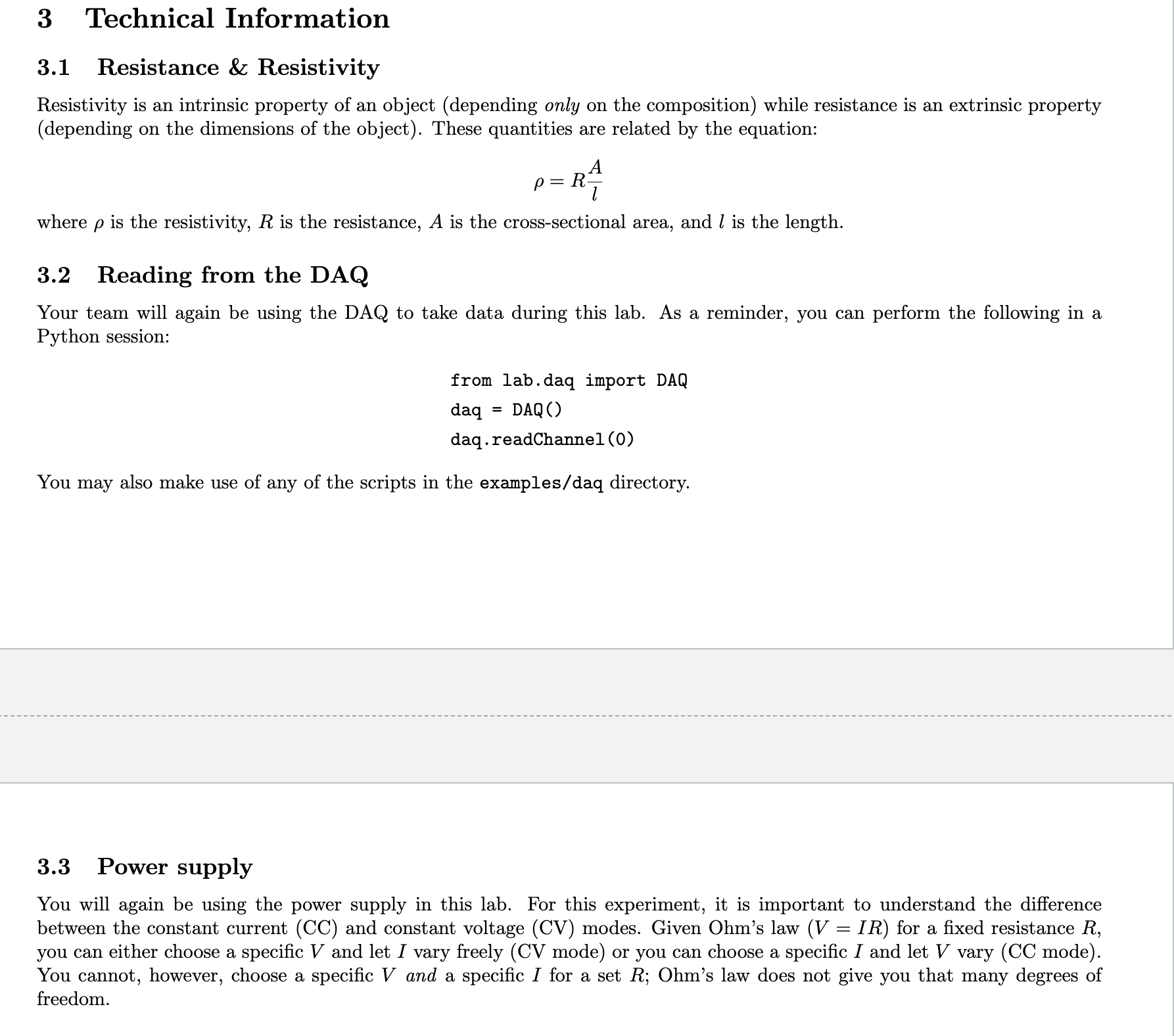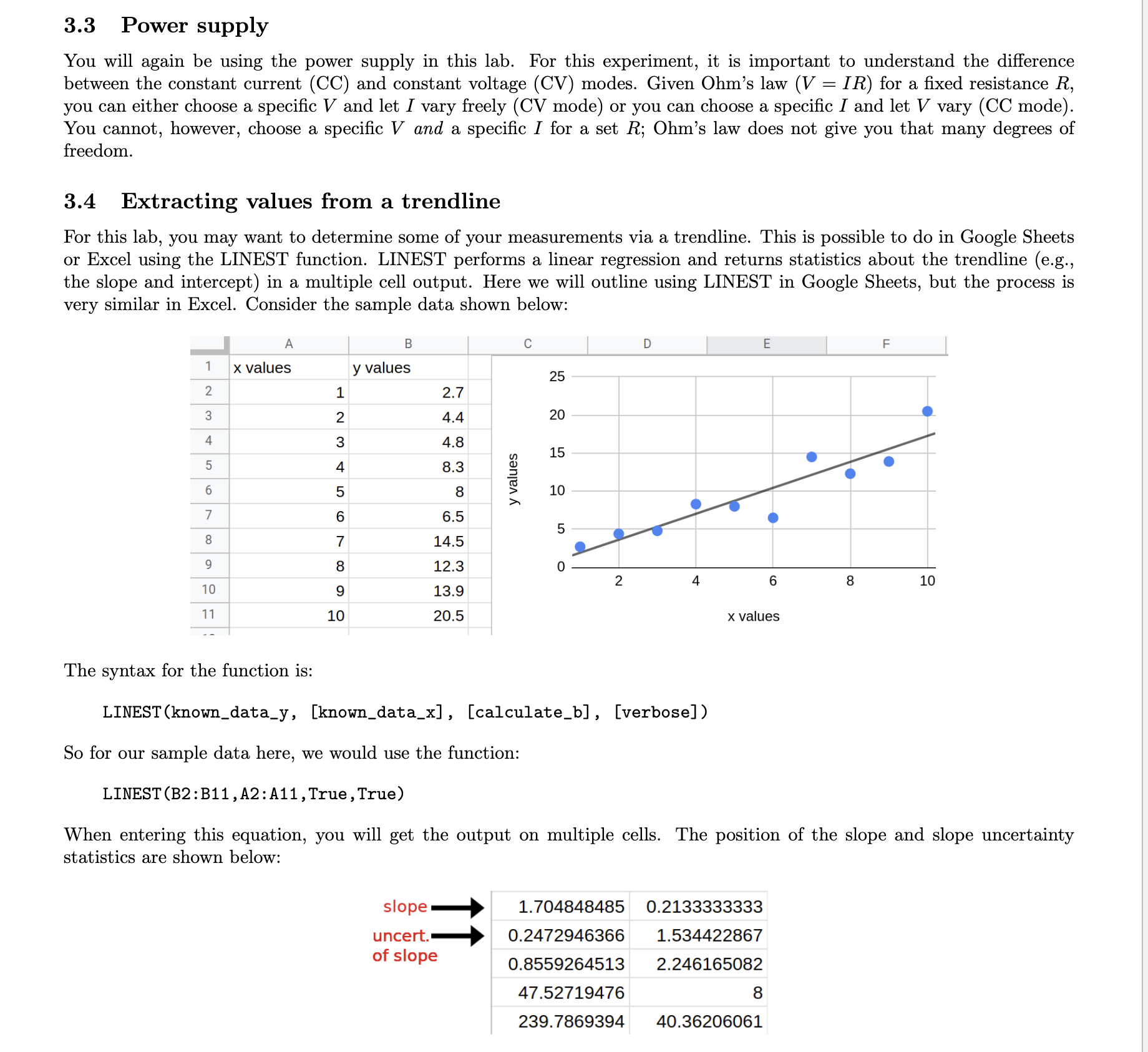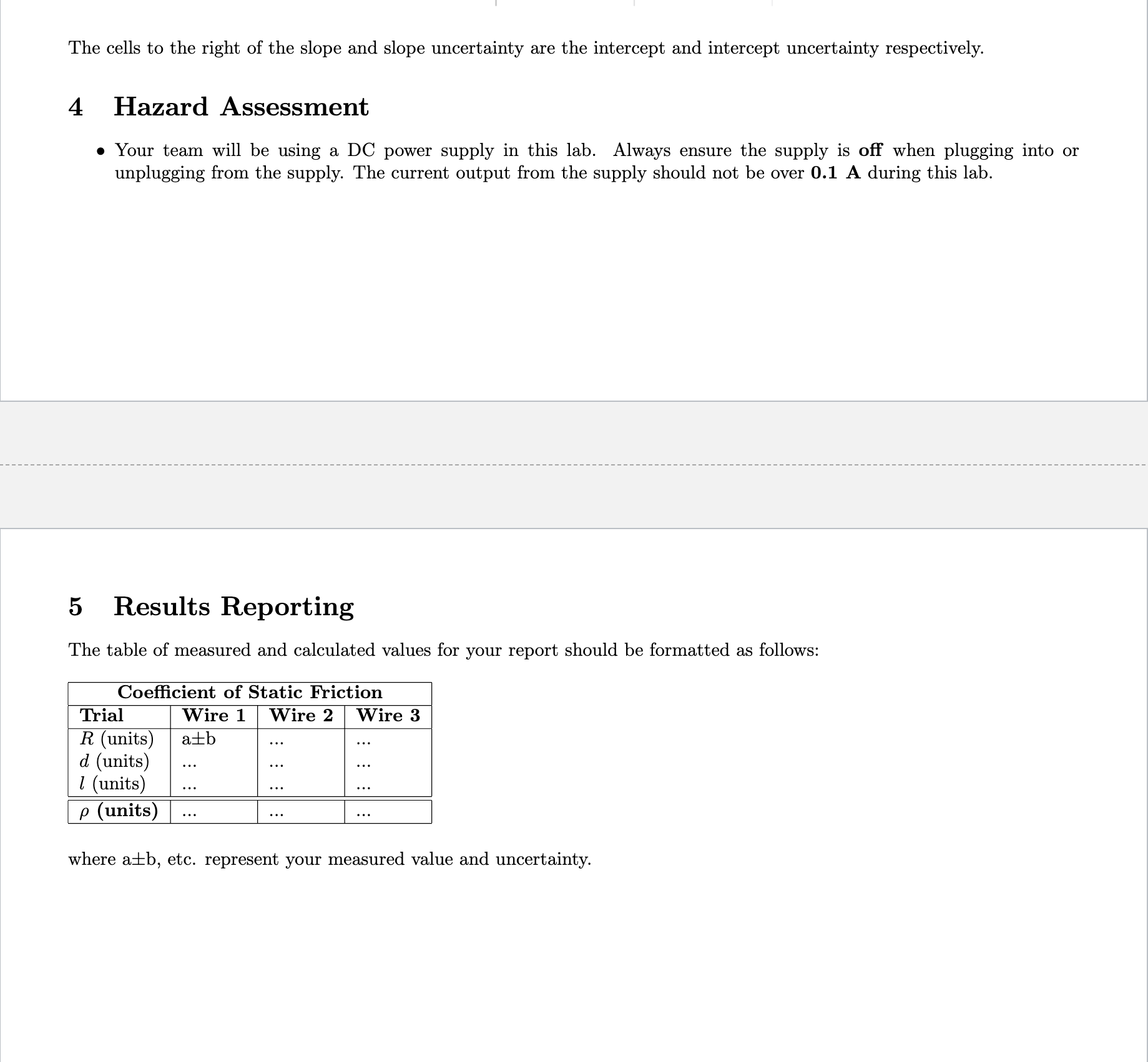Question
1. for a single wire, we need a plot of the voltage drop across a segment of wire (V ) as a function of the
1. for a single wire, we need a plot of the voltage drop across a segment of wire (V ) as a function of the length of
that segment of wire (l).
2. a plot of voltage drop across the entire wire (V ) as a function of current (I) through the wire, for each wire.
This should include a minimum of 5 different current values. This should demonstrate that each wire is an Ohmic
material (i.e., it behaves Ohm's law).
3. a table of the values and uncertainties measured for the resistance, R, the diameter, d, and the
length, l, of each wire. From those, compute the resistivity, , of each wire and propagate the uncertainty. An example
table is shown in Section 5.
4. a description of the process used to measure the values and uncertainties for R, d, and l in the previous
table.
5. assessment of each wire's composition based on your resistivity values
All the datas can be find here :
-Voltage_curent_data :
v_vs_i_wire_1 :
Current | Voltage |
0.1 | 0.608 |
0.09 | 0.547 |
0.08 | 0.487 |
0.07 | 0.425 |
0.06 | 0.364 |
0.05 | 0.304 |
0.04 | 0.242 |
0.03 | 0.181 |
0.02 | 0.121 |
0.01 | 0.058 |
v_vs_i_wire_2
Current | Voltage |
0.1 | 0.948 |
0.09 | 0.854 |
0.08 | 0.759 |
0.07 | 0.662 |
0.06 | 0.568 |
0.05 | 0.473 |
0.04 | 0.376 |
0.03 | 0.281 |
0.02 | 0.187 |
0.01 | 0.089 |
v_vs_i_wire_3
Current | Voltage |
0.1 | 1.562 |
0.09 | 1.407 |
0.08 | 1.251 |
0.07 | 1.091 |
0.06 | 0.935 |
0.05 | 0.78 |
0.04 | 0.619 |
0.03 | 0.464 |
0.02 | 0.308 |
0.01 | 0.148 |
-Voltage_lenght_data :
v_vs_l_wire_1 :
Applied length (mm) | Chnl. 0 (V) | Chnl. 0 uncert. (V) | |
0.0 | 0.005923828125 | 0.0009736595740586162 | |
50.0 | 0.0468837890625 | 0.0010745324999020002 | |
100.0 | 0.089900390625 | 0.0010988140631737777 | |
150.0 | 0.132298828125 | 0.001095746348788153 | |
200.0 | 0.172775390625 | 0.0010241062994708933 | |
250.0 | 0.2162607421875 | 0.0010568074032074437 | |
300.0 | 0.2597314453125 | 0.0010701983425769864 | |
350.0 | 0.2993876953125 | 0.0010459539072409897 | |
400.0 | 0.3417802734375 | 0.0009915080522796024 | |
450.0 | 0.3846005859375 | 0.0010530434411046177 | |
500.0 | 0.42491015625 | 0.001084707465750505 | |
550.0 | 0.4713193359375 | 0.0010693795648741595 | |
600.0 | 0.50947265625 | 0.0010809395581479755 | |
650.0 | 0.552017578125 | 0.0010157692411845666 |
v_vs_l_wire_2 :
Applied length (mm) | Chnl. 0 (V) | Chnl. 0 uncert. (V) |
0 | 0.008765625 | 0.000931806 |
50 | 0.06890625 | 0.00120958 |
100 | 0.139643555 | 0.001004771 |
150 | 0.205555664 | 0.001028952 |
200 | 0.27290625 | 0.001071404 |
250 | 0.339594727 | 0.000987725 |
300 | 0.406256836 | 0.00106675 |
350 | 0.475353516 | 0.00104188 |
400 | 0.539182617 | 0.000969967 |
450 | 0.60431543 | 0.001079058 |
500 | 0.672269531 | 0.001042997 |
550 | 0.737414063 | 0.001001244 |
600 | 0.803953125 | 0.001090359 |
650 | 0.869214844 | 0.00107976 |
v_vs_l_wire_3 :
Applied length (mm) | Chnl. 0 (V) | Chnl. 0 uncert. (V) | |
0.0 | 0.0088212890625 | 0.0009435544201631983 | |
50.0 | 0.116947265625 | 0.0010576994590144053 | |
100.0 | 0.223078125 | 0.0010446596195427128 | |
150.0 | 0.33540234375 | 0.0009909610868911159 | |
200.0 | 0.44537109375 | 0.001046762215531425 | |
250.0 | 0.5584833984375 | 0.000984694767921814 | |
300.0 | 0.667400390625 | 0.0010740985710473354 | |
350.0 | 0.7779375 | 0.001065515317222306 | |
400.0 | 0.887724609375 | 0.0010156424183452258 | |
450.0 | 0.9986337890625 | 0.0010685021002520786 | |
500.0 | 1.108271484375 | 0.0009923898565638853 | |
550.0 | 1.221509765625 | 0.001070722169758912 | |
600.0 | 1.325701171875 | 0.0010334115585333382 | |
650.0 | 1.4398916015625 | 0.0010228919514287864 |
Wire_measurements :
Overall wire length:
l = 705 5 mm
Wire 1 diameter:
d1 = 0.42 0.01 mm
Wire 2 diameter:
d2 = 0.34 0.01 mm
Wire 3 diameter:
d3 = 0.27 0.01 mm



Step by Step Solution
There are 3 Steps involved in it
Step: 1

Get Instant Access to Expert-Tailored Solutions
See step-by-step solutions with expert insights and AI powered tools for academic success
Step: 2

Step: 3

Ace Your Homework with AI
Get the answers you need in no time with our AI-driven, step-by-step assistance
Get Started


